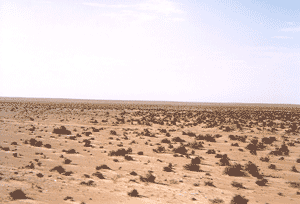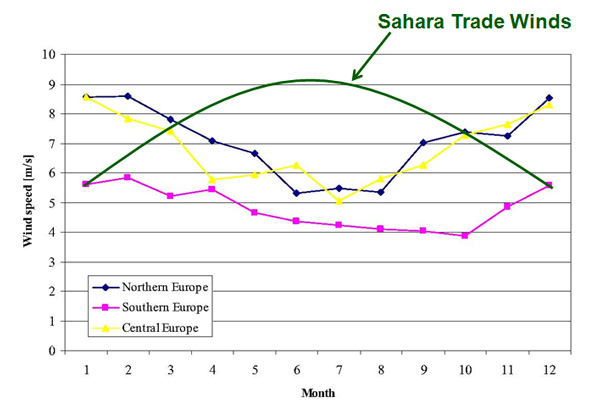As can be seen from the Global Wind Atlas, Atlantic trade winds extend far inland into the Sahara desert, where annual production from large wind parks can be as high as 0.1 to 0.15 TWhel/km². The establishment of wind turbines with a power density of 7 MW/km² could produce about 0.028 TWh/km² per year. Although close arrangements of wind turbines tends to weaken the global supply of energy of a Wind Park, wide space availability for large-scale wind installations enables an optimal wind turbine spacing to be applied.
 A wind turbine spacing of 4 MW/km² on parts of the 2000 kilometers long coastline from Morocco to Senegal could potentially generate a production of more than 11000 TWh per year. This exceeds the entire electricity needs of the European Union, estimated at 3200 TWh.
A wind turbine spacing of 4 MW/km² on parts of the 2000 kilometers long coastline from Morocco to Senegal could potentially generate a production of more than 11000 TWh per year. This exceeds the entire electricity needs of the European Union, estimated at 3200 TWh.
It represents many times the electricity demand of North African countries combined. Besides Power-to-X prospects, this wind potential cannot be utilized locally as electric load centers are remote from this region. Accessing it requires a technology available for much higher energy transfer capabilities, that smaller North African load centers cannot absorb.
A High Voltage Direct Current (HVDC) transmission line would enable vast amounts of green electricity to be transported to North African and European markets at minimal losses. With optimal load balancing for North Africa, a share of Europe’s wind and green hydrogen production could be complemented by large productive sites.
Comparative advantages would be achieved, as High Voltage Direct Current (HVDC) transmission technology stabilizes surrounding grids on both ends. Additional wind energy from local sources would feed a wider, more stable grid. Wind distributions in terms of seasonal peaks complement European winter wind highs, which can be offset by trade wind summer peaks. North Africa and Southern Europe's increased summer power demands can be met by electricity generated at very low costs.

Seasonal trends in reanalysis wind speed (Source EU data: TradeWind Project Doc. 11914/BT/01C)
Prospects from the Sahara Wind Project's HVDC line have been presented at the European Parliament in 2002. While EU and North-African regulations have made some progress, local wind projects already improved economies of marginal desert areas. This is critical as these have limited endogenous development possibilities.
From production figures and measurements collected on a regional basis, the trade winds blowing through the Saharan Atlantic coastline represent some of the world's largely untapped energy source. The size of this territory, the availability of wind and its geographical proximity to feed growing North-African and European electricity markets are very promising. Backed by such resource, the Sahara Wind project impacts regional wind developments towards a broad renewable energy transition.



